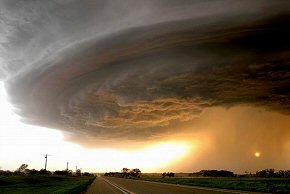26 July 2011
Predator-prey dynamics used to model cloud systems
by Kate Melville
 Mathematical formulae that describe the population dynamics of prey animals such as gazelles and their predators have been used to model the relationship between cloud systems and rain. Documented in the Proceedings of the National Academy of Sciences, the novel approach may help address the paucity of knowledge concerning cloud formation and the role that human-produced aerosols play.
Mathematical formulae that describe the population dynamics of prey animals such as gazelles and their predators have been used to model the relationship between cloud systems and rain. Documented in the Proceedings of the National Academy of Sciences, the novel approach may help address the paucity of knowledge concerning cloud formation and the role that human-produced aerosols play.
The eat-prey-rain approach is being put forward by Dr. Ilan Koren of the Weizmann Institute and Graham Feingold of the NOAA Earth System Research Laboratory in Colorado. They contend that the equations for modeling prey-predator cycles in the animal world are a handy analogy for cloud-rain cycles.
Just as respective predator and prey populations expand and contract at the expense of one another, so too rain depletes clouds, which grow again once the rain runs out. And just as the availability of grass affects herd size, the relative abundance of aerosols - which "feed" the clouds as droplets condense around them - affects the shapes of those clouds. A larger supply of airborne particles gives rise to more droplets, but these droplets are smaller and thus remain high up in the cloud rather than falling as rain.
In previous research, Feingold and Koren had discovered oscillations in convective cells in marine stratocumulus (the subtropical ocean clouds that cool the atmosphere by reflecting part of the incoming solar energy back to space). Revisiting their earlier data using a top-down approach, they developed a model showing that cloud-rain dynamics mimic three known predator-prey modes.
Like gazelles and lions, the two can oscillate in tandem, the "predator" rain cycle following a step behind peak cloud formation. Or the two can reach a sort of steady state in which the clouds are replenished at the same rate as they are diminished (as in a light, steady drizzle). The third option is chaos - the crash that occurs when predator populations get out of hand or a strong rain destroys the cloud system.
The model shows that as the amounts of aerosols change, the system can abruptly shift from one state to another. It also reveals a bifurcation - two scenarios at different ends of the aerosol scale that lend themselves to stable patterns. In the first, relatively low aerosol levels lead to clouds in which development depends heavily on aerosol concentrations. In the second, high levels produce saturation; these clouds depend solely on the initial environmental conditions.
Using this approach, says Koren, "can open new windows to view and understand the emergent behavior of the complex relationships between clouds, rain and aerosols, giving us a more useful view of the big picture and helping us to understand how shifting aerosol levels can lead to different climate patterns."
Related:
Predator-prey relationships a key driver in nature's synchronicity
Bacteria make rain, bioprecipitation researchers say
Of Pendulums And Predation
Bacterial Rainmakers Ubiquitous
Source: Weizmann Institute of Science
